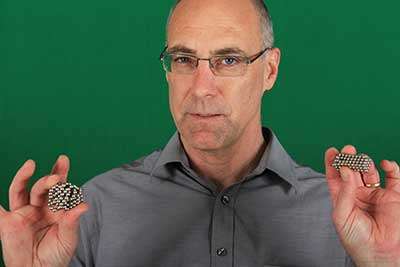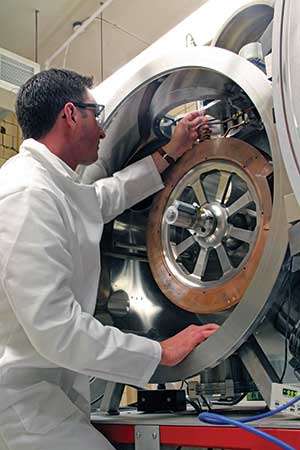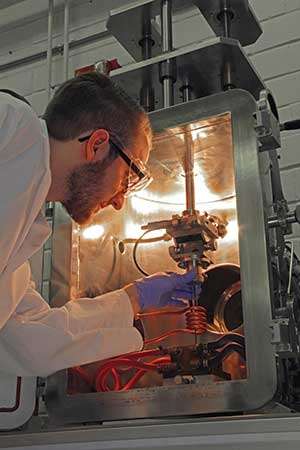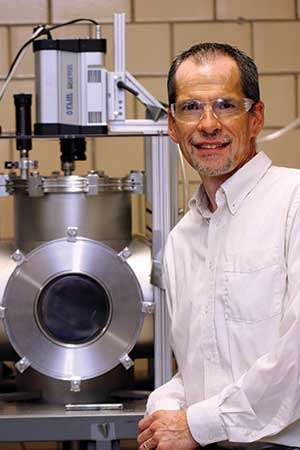Cooling materials super-quickly

Cooling materials super-quickly, called rapid solidification, prevents the normal crystalline structures of materials from forming, often creating unique properties in the process. If single crystal growth techniques sit at one end of the materials synthesis spectrum, promoting the growth of that material's equilibrium crystalline structure, rapid solidification techniques promote the opposite effect, cooling the material so quickly from liquid to solid, that the crystals formed are small, or in some cases non-existent, becoming amorphous or glass-like with no discernable crystalline pattern to their overall molecular structure.
It's also a way to form composite materials whose constituents have widely varying "freezing" temperatures.
"If you take a molten metal and cool it, what wants to form will vary depending on its chemistry," said Ames Laboratory scientist and Division of Materials Sciences and Engineering Director Matt Kramer, "because what wants to form is not always a homogeneous solid."
For example, if you freeze a mixture of water and alcohol, the water will solidify first—turning to ice—while the alcohol remains liquid, leaving a slushy mixture until the temperature is lowered to the alcohol's freezing temperature.
"So when you cast a molten alloy, small crystals will form quickly on the surface of the mold, you get segregation of the materials and the remaining liquid becomes enriched," said Kramer, who is also an Iowa State University adjunct professor of materials science and engineering, "which results in a heterogeneous bulk material."
Rapid solidification allows the material to cool extremely quickly so as to suppress or even eliminate the segregation. Techniques range from strip casting, which cools materials at about 1,000 Kelvins per second to splat quenching which, as the name implies, squashes a droplet of liquid material between two plates. Splat quenching can cool the material as high as 108 Kelvins per second.
"Why is that important? Because there's an intimate relationship between temperature and the time at which materials cool," Kramer said. "We call it TTT—Time-Temperature Transformation."
It takes a certain finite amount of time for the initial crystals to form, a process called nucleation. The molten material has to organize itself into crystals only a few 10s of atoms across and then those crystals need to grow.
"There's a very non-linear relationship between time and temperature transformation," Kramer continued. "Solidification occurs over a broad range of temperatures. At too high a temperature, it stays molten. At a temperature just below the melting temperature, the material solidifies slowly, and in cases where constituents have different melting temperatures, significant segregation in the casting can occur if cooled slowly.
Rapid solidification techniques allow researchers to bypass the time-temperature transformation so a molten metal alloy forms without a crystalline order, creating a metallic glass.

"Glassy metals have some very unusual properties," Kramer said. "On average, they tend to have very good strength, but not much plasticity, so they are hard to mold into shapes."
However, by first forming a metallic glass, then heating the material back up, researchers can achieve metastable phases of the material that aren't attainable by other methods, such as casting. And these intermediate phases may have desirable properties such as strength, ductility, resistivity, or conductivity.
"Manipulating the phases, their sizes, the degree at which we can control their growth, and even their morphology, or shapes, are all buried in the details of the classical time-temperature transformation," Kramer said. "A lot of the work we're doing is trying to understand the relative balance of cooling rates to phase selection process. How can we predict and control those so we can move beyond an Edisonian approach."
Researchers at Ames Laboratory use several techniques including melt spinning and injection casting to produce small-grained and amorphous materials.
Melt spinning
This technique involves shooting a stream of molten material onto a spinning copper wheel where it solidifies quickly, forming a ribbon of metal. The copper wheel is typically water cooled and depending on the speed at which it spins, up to 30 meters per second, the molten metal is quenched up to 106 Kelvins per second.
"There are limits to the process," said Ames Laboratory scientist and ISU associate professor of materials science and engineering Jun Cui. "The copper wheel must be perfectly balanced to spin at such high speeds. And beyond a certain point, the material no longer flows in a ribbon but breaks apart."
There is also a variation in the process where the copper wheel has small grooves cut across its surface. These grooves intentionally break the cooled metal into short strips, which
Cui said are easier to work with in some applications.

Injection casting
As the name implies, injection casting forces the molten material into a copper mold, typically a small cylinder that will produce short rods one to four millimeters in diameter.
The mold is held inside a larger water-cooled copper mold providing quench rates fast enough to produce amorphous (glassy) samples in some alloys.
"Small samples—usually less than five grams—are placed in a graphite or quartz nozzle and rapidly heated by induction to several hundred degrees above the melting point," said Matt Besser, Ames Laboratory scientist and manager of the Laboratory's Materials Preparation Center. "We then drop it out of the heating zone and pressurize the system so the material squirts into the mold."
By using different shaped molds, material can be cast in plates, or wedges. Besser said thermocouples can be placed along the length of the wedge to measure the difference in cooling rates from the fastest at the thin tip to the slowest at the thicker end.
"We're able to fabricate samples to fit specific needs," Besser said, "and it's convenient because we can produce small samples, especially when the alloy contains expensive materials."
Seeking explanations for solidification puzzles
One of the most common and robust ways to create a new material, particularly a metallic alloy, is to melt two or more constituent materials, mix them in the liquid state, then freeze or "solidify" them under certain controlled conditions. While seemingly simple, solidification processing can produce an incredible variety of material structures with important features on scales from nanometers to centimeters, giving rise to a host of remarkable properties ranging from enhanced strength and stiffness to unusual magnetic, thermal, electrical, and photonic properties.
But the make-up and structure, and therefore the properties, of that end result can vary greatly depending on a variety of conditions present as the material transitions from liquid to solid. Ames Laboratory scientist Ralph Napolitano works to explain and predict what takes place at that liquid-solid interface and how those various interactions result in certain structures, chemistries and properties.
"When a material goes from a liquid to a solid phase, a lot of things must happen as part of that transformation," said Napolitano, who is also an Iowa State University professor of materials science and engineering. "Nominally speaking, an amorphous or non-crystalline liquid phase has to reconfigure itself into some kind of crystalline packing. But many other simultaneous events are taking place to make that happen. Indeed, it is the way that the different transport processes and different structural entities enter into that equation that really influences what that final structure may look like."

If equilibrium yields the normal or expected result, there are all kinds of deviations that can shift the result from equilibrium. Some of them are very small deviations, such as slightly different chemical compositions or slightly different concentrations of different kinds of crystalline defects. Deviations can also be very large—completely different crystalline packing or composition or even an array of multiple phases that you might never see closer to equilibrium.
"What dictates how far away from the final equilibrium state you might be is what happens along that pathway from the equilibrium liquid to this far-from-equilibrium structure," Napolitano said. "Varying the composition of a material and the rate at which we cool it has dramatic influence over final phase or assembly."
"Beyond just the phase—the particular crystalline structure—conditions during freezing greatly influence the growth morphology," he continued. "Any given phase will grow with a certain morphology that is dynamically optimized with respect to all of the different processes—such as the redistribution of heat, chemical species, and configuration of crystalline defects—making the overall transformation more efficient. Composition and cooling rate, along with the phase itself and the energies of the crystal defects and interfaces, all play a role in this collective dynamical optimization, ultimately resulting in the selection of the final state, which may look nothing like the equilibrium state.
"This far-from-equilibrium synthesis provides a portal or pathway to structures, chemistries, and properties that aren't accessible through conventional methods," Napolitano said.
To complicate matters, these pathways may include several other steps —before and after solidification, so that the complex freezing structure may only serve as some intermediate stage, along the way to a desired structure.
Cooling rate provides a high level of control in certain windows. At the low (slow) end, cooling rate can be controlled very carefully, and even cooling rates from isothermal treatments to 100 degrees per second can be controlled reasonably well.
"We can go to cooling rates of 103 to 104 degrees per second with techniques like melt spinning, but within that window, process control is challenging and local variations exist," Napolitano said. "We have investigated such variations, and our understanding has certainly increased. Even so, with relatively few 'process knobs' to turn (e.g. melt temperature, wheel speed, wheel material, injection rate and stream diameter), precise quantitative control remains a real challenge."
As a strategy to reveal a clearer picture of the complex behaviors, Napolitano's group has chosen to focus on a few select two-component or "binary" systems. In particular, binary systems, such as copper-zirconium and aluminum- samarium, provide great opportunities to investigate far- from-equilibrium transformation. These systems exhibit complex competitive solidification, glass formation, and crystallization, forming a host of non-equilibrium phases and multi-scale growth structures. At the same time, with only two components, analytical and computational treatment of the thermodynamics and kinetics become more tractable, compared with multi-component systems.
"With both of these systems, there's a composition range over which the liquid forms a glass rather easily so you can cool it at rates that are achievable experimentally," Napolitano said. "Once the alloy is glassy, other treatments can be used to crystalize the material at low temperature. In this regime, conditions can be controlled carefully, and reactions can be slowed substantially, even permitting in-situ real-time investigation. Of course, having an accurate and comprehensive picture of the system thermodynamics is critical. Whether you're solidifying the material directly from a liquid, or first quenching to a glass and then heating to crystallize the material, you still have that same thermodynamic playing field."
The aluminum-samarium work is being expanded to a larger range of binaries, including other aluminum-rare earth alloys. In general, those systems are expected to exhibit similar behaviors, though Napolitano warns that very subtle effects can dramatically tip the balance between different phases and growth structures. Very small energetic differences exist between the competing phases. Under high driving forces, these differences are often negligible and the kinetic pathways control the outcome. Even changes in chemical composition on the order of a percent or less can dramatically change the final state.
"This kind of study is only possible by bringing together many different approaches in theoretical condensed matter physics, materials science, computational thermodynamics, materials synthesis, and state-of-the-art characterization," Napolitano said. "There is no doubt that this work requires the full gamut of experimental and computational capability and a team of investigators with a broad range of expertise."
To that end, the new electron microscopy equipment at Ames Laboratory's Sensitive Instrument Facility (SIF) will play a vital role. "It's important not only in terms of spatial resolution, but some of the in situ capabilities as well," he said. "Hot-stage transmission electron microscopy with atomic scale resolution will allow us to look at some of the early stage dynamics that really are watershed events that tend to send the material down a whole different trajectory. So absolutely, the SIF is critical to moving forward in this area."
Provided by Ames Laboratory





















